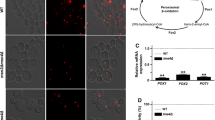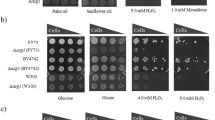Abstract
The Saccharomyces cerevisiae transcriptional activator ADR1, which controls ADH2 gene expression, was shown to be involved in the regulation of peroxisome proliferation. To study the mode of action of ADR1, we compared strains carrying the adr1-1 mutation, high or low copy numbers of the ADR1 gene, the constitutive allele ADR1-5 c, and 3′-deletions of ADR1. High ADR1 gene dosage increased the transcription of genes encoding peroxisomal proteins as compared to one copy of the ADR1 gene. Furthermore, overexpression of ADR1 under ethanol growth conditions induced the proliferation of peroxisomal structures. The organelles were observed to be localized in clusters, a typical feature of peroxisomes induced by oleic acid. In contrast, the ADR1-5 c allele, which induces ADH2 expression to a level comparable to that of high ADR1 gene dosage was found to have only a small effect. An analysis of functional domains of the ADR1 protein revealed that the N-terminal 220 amino acids of ADR1 were sufficient for wild-type levels of transcription of the FOX2, FOX3, and PAS1 genes, but the entire ADR1 protein was required for complete induction of the CTA1 gene and for growth oleic acid medium. Our data suggest that a functional domain of the ADR1 protein localized between residues 643 and 1323 is required for the induction of peroxisomal structures and for the utilization of oleic acid.
Similar content being viewed by others
References
Bemis LT, Denis CL (1988) Identification of functional regions of the yeast transcriptional activator ADR1. Mol Cell Biol 8:2125–2131
Cohen G, Fessl F, Traczyk A, Rytka J, Ruis H (1985) Isolation of the catalase A gene of Saccharomyces cerevisiae by complementation of the cta1 mutation. Mol Gen Genet 200:74–79
Cook WJ, Chase D, Audino DC, Denis CL (1994a) Dissection of the ADR1 protein reveals multiple, functionally redundant activation domains interspersed with inhibitory regions: evidence for a repressor binding to the ADR1c region. Mol Cell Biol 14:629–640
Cook WJ, Mosley SP, Audino DC, Mullaney DL, Rovelli A, Stewart G, Denis CL (1994b) Mutations in the zinc-finger region of the yeast regulatory protein ADR1 affect both DNA binding and transcriptional activation. J Biol Chem 269:9374–9379
Denis CL (1987) The effect of ADR1 and CCR1 gene dosage on the regulation of the glucose-repressible alcohol dehydrogenase from Saccharomyces cerevisiae. Mol Gen Genet 229:395–399
Denis CL, Ciriacy M, Young ET (1981) A positive regulator is required for the accumulation of the functional mRNA for the glucose repressible alcohol dehydrogenase from Saccharomyces cerevisiae. J Mol Biol 148:355–368
Denis CL, Fontaine SC, Chase D, Kemp BE, Bemis LT (1992) ADR1c mutations enhance the ability of ADR1 to activate transcription by a mechanism that is independent of effects on cyclic AMP-dependent protein kinase phosphorylation of Ser-230. Mol Cell Biol 12:1507–1514
Einerhand AWC, Voorn-Brouwer TM, Erdmann R, Kunau W-H, Tabak HF (1991) Regulation of the gene coding for peroxisomal 3-oxoacyl-CoA thiolase of Saccharomyces cerevisiae. eur J Biochem 200:113–122
Einerhand AWC, Kos WT, Distel B, Tabak HF (1993) Characterisation of a transcriptional control element involved in proliferation of peroxisomes in yeast in response to oleate. Eur J Biochem 214:323–331
Erdmann R, Veenhuis M, Mertens D, Kunau W-H (1989) Isolation of peroxisome deficient mutants of Saccharomyces cerevisiae. Proc Natl Acad Sci USA 86:5419–5423
Erdmann R, Wiebel FF, Flessau A, Rytka J, Fröhlich KU, Kunau W-H (1991) PAS1, a yeast gene required for peroxisome biogenesis, encodes a member of a novel family of putative ATPases. Cell 64:499–510
Filipits M, Simon MM, Rapatz W, Hamilton B, Ruis H (1993) A Saccharomyces cerevisiae upstream activating sequence mediates induction of peroxisome proliferation by fatty acids. Gene 132:49–55
Hartig A, Ogris M, Cohen G, Binder M (1990) Fate of highly expressed proteins destined to peroxisomes in Saccharomyces cerevisiae. Curr Genet 18:23–27
Hiltunen JK, Wenzel B, Beyer A, Erdmann R, Fossa A, Kunau W-H (1992) Peroxisomal multifunctional beta-oxidation protein of Saccharomyces cerevisiae-molecular analysis of the FOX2 gene and gene product. J Biol Chem 267:6646–6653
Lazarow PB, Fujiki Y (1985) Biogenesis of peroxisomes. Annu Rev Cell Biol 1:489–530
Pavlik P, Simon MM, Schuster T, Ruis H (1993) The glycerol kinase (GUT]) gene of Saccharomyces cerevisiae: cloning and characterization. Curr Genet 24:21–25
Sambrook J, Fritsch EF, Maniatis T (1989) Molecular cloning. A laboratory manual. Cold Spring Harbour Laboratory, Cold Spring Harbour, New York
Simon MM, Adam G, Rapatz W, Spevak W, Ruis H (1991) The Saccharomyces cerevisiae ADR1 gene is a positive regulator of transcription of genes encoding peroxisomal proteins. Mol Cell Biol 11:699–704
Simon MM, Binder M, Adam G, Hartig A, Ruis H (1992) Control of peroxisome proliferation in Saccharomyces cerevisiae by ADR1, SNF1 (CAT1, CCR1) and SNF4 (CAT3). Yeast 8:303–309
Skoneczny M, Chelstowska A, Rytka J (1988) Study of the coinduction by fatty acids of catalase A and acyl-CoA oxidase in standard and mutant Saccharomyces cerevisiae strains. Eur J Biochem 174:297–302
Subramani S (1993) Protein import into peroxisomes and biogenesis of the organelle. Annu Rev Cell Biol 9:445–478
Thukral SK, Tavianni MA, Blumberg H, Young ET (1989) Localization of a minimal binding domain and activation regions in yeast regulatory protein ADR1. Mol Cell Biol 9:2360–2369
Thukral SK, Eisen A, Young ET (1991) Two monomers of yeast transcription factor ADR1 bind a palindromic sequence symmetrically to activate ADH2 expression. Mol Cell Biol 11:1566–1577
Vallari RC, Cook WJ, Audino DC, Morgan MJ, Jensen DE, Laudano AP, Denis CL (1992) Glucose repression of the yeast ADH2 gene occurs through multiple mechanisms, including control of the protein synthesis of its transcriptional activator, ADR1. Mol Cell Biol 12:1663–1673
Van der Klei IJ, Rytka J, Kunau W-H, Veenhuis M (1990) Growth of catalase A and catalase T deficient mutant strains of Saccharomyces cerevisiae on ethanol and oleic acid. Arch Microbiol 153:513–517
Veenhuis M, Mateblowsky M, Kunau W-H, Harder W (1987) Proliferation of microbodies in Saccharomyces cerevisiae. Yeast 3:77–84
Author information
Authors and Affiliations
Additional information
Communicated by C. P. Hollenberg
Rights and permissions
About this article
Cite this article
Simon, M.M., Pavlik, P., Hartig, A. et al. A C-terminal region of the Saccharomyces cerevisiae transcription factor ADR1 plays an important role in the regulation of peroxisome proliferation by fatty acids. Molec. Gen. Genet. 249, 289–296 (1995). https://doi.org/10.1007/BF00290529
Received:
Accepted:
Issue Date:
DOI: https://doi.org/10.1007/BF00290529




